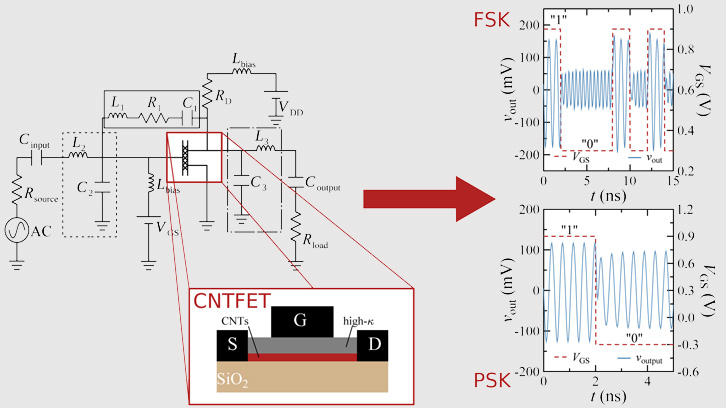Towards the development of multifunctional circuits using emerging carbon-based devices

During the last years, the claim of high-performance communication systems has increased as a result of the requirements of the population for more and better connectivity options. Emerging semiconductor technologies, e.g., carbon-based devices, have emerged as a short-term alternative to increase the performance limits of the integrated circuits. In particular, carbon nanotubes (CNTs) appeared as an option to use on the channel of new-generation field-effect transistors (FETs). Opening the door to being used during the design of radiofrequency circuits, using the intrinsic characteristics of the CNTs, such as ambipolarity, in order to design high-performance multifunctional circuits.
The intrinsic characteristics of Carbon Nanotube Field-Effect Transistors (CNTFETs); quasi-ballistic transport, excellent gate control, ambipolarity, and high inherent linearity, make them serious contenders for the development of low-power high-frequency applications (even with frequencies close to 100 GHz [1]). Ambipolarity (both n-type and p-type transport enabled) in particular, allows the design of circuits with multiple functions, for example; frequency multipliers, amplifiers, or modulators, based on a single device. In contrast to using multiple circuits for specific functions, designing multifunctional circuits based on emerging technologies in a monolithic circuit implies a reduction in fabrication processes and production costs, as well as achieving a smaller device footprint and high-performance low-consumption circuits. These characteristics make them highly desirable to meet current industry requirements.
In this context, a joint research has been developed between the Department of Electronic Engineering of the Autonomous University of Barcelona and the Instituto Politécnico Nacional in Mexico [2], in order to study the feasibility of using CNTFETs in the design of high-frequency multifunctional circuits. For this purpose, a computationally efficient compact model that adequately describes the physical phenomena within the CNTFET is required for circuit design. In this work, a large-signal compact model of CNTFETs, calibrated to experimental data has been used [3, 4]. As a result of this international collaboration, a pair of novel multifunctional circuits have been proposed, each with two modes of operation: a configurable frequency amplifier and a configurable phase amplifier. In both cases, it was possible to demonstrate that ambipolarity in CNTFETs can be used for this type of application with simple topologies in circuit design, where coupling networks capable of working appropriately in both operating modes were also considered.
Furthermore, a pair of PSK and FSK modulators - fundamental circuits for high-data-rate communication systems - based on CNTFETs, were proposed for the first time using these multifunctional circuits. It was observed that these types of modulation schemes are capable of being implemented at high-frequency ranges, e.g., 2.4 GHz, using a single transistor by switching its gate bias. In this way, the digital and analog blocks of a communication system can be easily combined.
By using sophisticated and experimentally validated compact physical models, it is possible to achieve, in conjunction with an efficient circuit design, performance projections, such as the one presented in this work, that involve emerging technologies such as CNTFETs. In order to promote this type of technology, the collaboration between manufacturing groups and the ones dedicated to the study of device modeling and circuit design, is essential.
These types of studies are of special interest to demonstrate that ambipolar devices, such as CNTFETs, can be considered as serious short-term contenders to be used in the design of high-frequency and high-efficiency multifunctional solutions in monolithic integrated circuits. Furthermore, the results obtained can be extrapolated to research other types of ambipolar devices such as graphene-based field-effect transistors.
Javier N. Ramos-Silva1, Aníbal Pacheco-Sánchez2, Eloy Ramírez-García1, David Jiménez2
1Instituto Politécnico Nacional, UPALM (México)
2Department of Electronic Engineering
School of Engineering
Universitat Autònoma de Barcelona
References
[1] C. Rutherglen et al., Wafer-scalable, aligned carbon nanotube transistors operating at frequencies of over 100 GHz, Nature Electronics, vol. 2, pp. 530-539, Nov. 2019. doi: 10.1038/s41928-019-0326-y
[2] J. N. Ramos-Silva, A. Pacheco-Sanchez, E. Ramírez-García, D. Jiménez, Multifunctional High-Frequency Circuit Capabilities of Ambipolar Carbon Nanotube FETs, IEEE Transactions on Nanotechnology, vol. 20, pp. 474-480, May 2021, doi: 10.1109/TNANO.2021.3082867.
[3] M. Schröter, M. Haferlach, A. Pacheco-Sanchez, S. Mothes, P. Sakalas, M. Claus, A Semiphysical Large-Signal Compact Carbon Nanotube FET Model for Analog RF Applications, IEEE Trans. Electron Devices, vol. 62, no. 1, pp. 52-60, Jan. 2015. doi: 10.1109/TED.2014.2373149
[4] M. Schröter, M. Haferlach, M. Claus, CCAM Compact Carbon Nanotube Field-Effect Transistor Model (Version 2.0.3), nanoHUB. doi: 10.4231/D3VD6P595, 2015.


